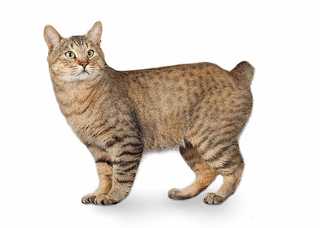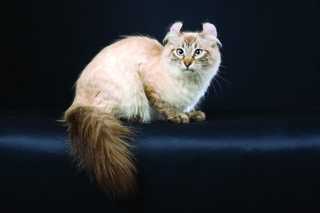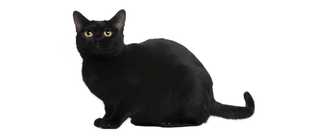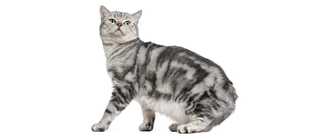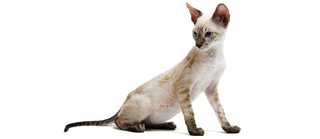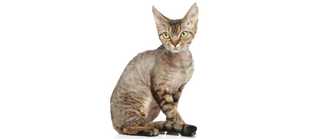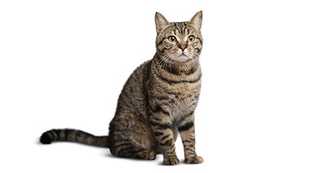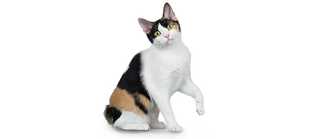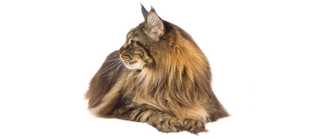
Note: While the breeds in this collection tend to be Black, individual pets will vary. Please consult the adoption organization for details on a specific pet.
A hair-raising 29% of black cats, more than any other color, are being given a second chance at a new life with great families. According to research, black kittens and black cats are showing the healthiest adoption rates that rescue groups have seen in years.
These positive adoption percentages are proving that myths are being replaced by a deep appreciation of black cat cultural impact, history and their amazing, multiple all-black colors. With mystical breed names like the Bombay, Sphynx and Oriental, a black cat is attractive to feline-lovers for many reasons other than their bold, sleek coats and big, bright eyes.
Just like their many shades of black, black cat breeds are beloved for their diverse personalities, quirky characteristics and range of grooming requirements from easy to special. Learn more about the types of black cat breeds that can be a great addition to your family too.
1. American Bobtail
Believed to be a cross between a Siamese and short-tailed tabby, the American Bobtail features elongated hind legs and a tail one-third to one-half the length of a regular cat’s tail. Bobtails born with no tail are called rumpies.
Personality: Playful, energetic and friendly.
Grooming: Easy maintenance. Long or medium coats need twice a week brushing, regular nail trims, ear and dental care.
2. American Curl:
Recognized by their distinctively curled-back ears, a genetic mutation in the domestic cat population, the American Curl is not born with instantly whimsical ears. The ear curl begins at around three weeks old and continues to form over the next four months before settling into a permanent shape.
Personality: Affectionate, outgoing, great with children.
Grooming: Easy maintenance. Coat needs twice a week brushing, regular nail trims and ear cleaning and frequent dental care.
3. American Shorthair
Descended from European felines, American Shorthairs came with the early settlers, brought along on ships to guard cargo and property from rodents.
Personality: Quiet, sociable, versatile and adapt well in a home with children and other pets.
Grooming: Mild maintenance. Coat is dense needing weekly brushing, regular nail, ear and dental care.
4. Bombay:
Named after the Indian city that the black panther calls home, the Bombay was developed from a sable Burmese and American Shorthair cat. The breed is instantly recognizable by her solid black coat and striking yellow eyes.
Personality: Friendly, affectionate, active, loves children.
Grooming: Easy maintenance. Coat should be brushed weekly with regular nail trim and dental care and occasional ear cleaning.
5. British Shorthair:
With her 2000 year-old lineage traced back to the Roman Empire, the British Shorthair roamed the streets of the United Kingdom for decades before being raised to an official breed status.
Personality: Cuddly, calm, loving, family-orientated.
Grooming: Easy maintenance. Coat is should be combed weekly with regular nail trim, ear and dental care.
6. Cornish Rex:
With short, curly hair, large, prominent ears and wavy whiskers – it’s not hard to miss the Cornish Rex. A migrant of Cornwall in England, the breed is beloved for her interest in everything her companions are doing.
Personality: Active, playful, adventurous and easy to travel with.
Grooming: Easy maintenance. Coat requires bushing every other week and regular nail trims, ear and dental care.
7. Devon Rex:
Pixie-like features instantly endear you to the Devon Rex, once a native of Buckfastleigh, Devon in England. Her creation was quite accidental, when a tom met a tortoiseshell, but her breed’s popularity is not.
Personality: Highly social, entertaining and clown-like.
Grooming: Special maintenance. Bath bi-weekly to keep her skin healthy, gentle brushing, occasional ear clean and regular nail and dental care.
8. Exotic Shorthair:
Distinguished by her short, plush coat but with all the features of an aristocratic Persian – Exotics are known for their teddy bear looks, easy maintenance and of course that shiny, dense coat.
Personality: Fun-loving, athletic and sensitive.
Grooming: Special maintenance. Bath and brush bi-weekly to rid her of her seasonal shed, regularly clean eyes to ensure no tear stains. Trim nails as needed.
9. Japanese Bobtail:
Steeped in Eastern legend and tradition, Japanese Bobtails are considered one of the oldest cat breeds, dating back to the seventeenth century. The breed’s existence is sealed in historical writings and folklore that tells of Bobtails believed to bring good luck and prosperity.
Personality: Bold, alert, vocal and highly intelligent.
Grooming: Special maintenance. An undercoat means frequent brushing twice a week, more in shedding season, regular nail and ear care.
10. Maine Coon:
A gentle giant, Maine Coons are American natives dating back to the colonial days where their mousing skills were put to work in homes, barns and ships. Adapting to survive the severe Maine climate, the breed has developed into a large, robust cat with a thick, water-repellent coat.
Personality: Devoted, loving, curious.
Grooming: Mild maintenance. Dense, shaggy coat needs weekly brushing and regular dental care, nails can be trimmed bimonthly.
11. Norwegian Forest Cat:
The Viking skogkatt (forest cat) of Norway first appeared in Norse mythology 4000 years ago but the breed’s lineage is likely longer. Norwegians have long been a member of the family on farms and ships, responsible for maintaining the mouse population.
Personality: Athletic, people-loving, mellow, child-friendly.
Grooming: High maintenance. Long, double, water-resistant coat needs brushing twice a week plus regular ear, nail and dental care.
12. Oriental:
Regal in stature, it’s clear to see why this breed’s original Siamese ancestor was a permanent fixture in the Royal Palace of Siam (Thailand). Today’s long and short hair Orientals, with their flared, large ears and almond-shaped eyes, are distinguished by the breed’s variety of colors and patterns – including midnight black.
Personality: Lively, curious, vocal, tends to bond with one pet lover in the home.
Grooming: Special maintenance. Long and short coats need regular brushing, or a rub-down with a damp cloth, plus nail and ear care.
13. Persian:
Introduced to Europeans in the 1500s by Roman and Phoenician caravans from Persia (Iran) and Turkey, the elegant Persian is best recognized for her long, silky coat, flatter face with snub nose and bright, golden eyes.
Personality: Sweet-tempered, docile, discreet and best matched to older, quieter homes.
Grooming: High-maintenance. Coat needs daily brushing and weekly bathing with regular eye, nail and dental care.
14. Scottish Fold
Discovered by a Scottish shepherd in the 60s, the Scottish Fold features large, wide eyes and forward-folding ears. Her ears are a spontaneous mutation that affects the cartilage, giving her an owl-like or teddy-bear look. She can be found in both a long and short hair version.
Personality: Intelligent, adapts to new friends and places, often bonds with one pet lover in the home.
Grooming: Easy maintenance. Coat should be combed twice a week with regular nail trims, dental care and occasional ear cleaning.
15. Selkirk Rex
The Selkirk shares her curly coat with her Rex relatives but differs in personality and body type thanks to a crossing with Persians, Exotic and British Shorthairs. She is named after the Selkirk Mountains in Montana where she was first discovered.
Personality: Highly social, devoted and playful right into seniority.
Grooming: Special maintenance. Coat needs specific combing technique to ensure curls are not stretched out. Regular nail, eye, ear and dental care.
16. Siberian:
Russia’s national treasure is fascinated by running water, making playtime as easy as turning on a faucet for a Siberian. Her thick, triple, water-resistant coat has helped her survive the harsh Siberian terrain for the last 1000 years where she has helped maintain rodent populations.
Personality: Agile jumpers leaping great distances, smart, friendly.
Grooming: Mild maintenance. A triple coat growing thicker in winter and sheds seasonally needs weekly brushing with regular nail, teeth and ear cleaning.
17. Sphynx:
Distinguished by her lack of coat and wrinkly skin, the Sphynx is a hairless cat breed that is surprisingly not considered hypoallergenic. She sheds dead skin cells called dander, like most animals. As exotic and ancient as she appears, Sphynx originated from Canada in the late 60s.
Personality: Good-natured, inquisitive, needs companionship.
Grooming: Special maintenance. Sphynx’s skin needs weekly sponge baths to remove sebaceous oils, regular nail, eye, ear and dental care.
18. Turkish Angora:
Possibly the first cat in Europe, Turkish Angora’s are highly valued by the Turkish people. The breed’s lineage traces back to the earliest days of Islamic faith founder Mohammed in 570-632 A.D. who regarded his cat as a prized companion.
Personality: Graceful, extroverted, entertaining, great swimmers.
Grooming: Mild maintenance. Weekly brushing with a bath every few months plus regular nail, eye, ear and dental care.
How Are Black Cats Different From Other Cats?
If their striking raven color or breed dominance of hypoallergenic cats for people with allergies isn’t enough to separate them from the rest of the cat population, then a black cat’s personality definitely redefines their uniqueness. Black cats are a mixed bag of contradictions, being the most closely related to their wild ancestors and sharing similarities like having a wild and impulsive side and being stubborn and friendly at the same time; or, demanding freedom but crave a closeness with their human caretakers and other pets in the home.
With such diverse personalities amongst these breeds, you may find yourself wondering whether, as black cat pet parents – just who claims ownership over whom?
Black cats can sometimes be healthier than their colorful cousins, thanks to a high content of melanin that increases resistance to pathogenic infections.
How have black cats impacted cultures?
These color-blocked breeds are most famously associated with Egyptian royalty where black cats were considered God-like and killing one was a capital crime. The breed’s cultural impact has not lost its power over the centuries despite Western, old wives tales.
- Japan: Female black cat pet parents are considered more attractive to male suitors.
- England: Black cats as a wedding gift to Midlands brides is said to bring good luck and happiness.
- Great Britain: British sailors believed a black cat breed on board would not only ensure the ship’s good luck but return them home safely.
- Scotland: A black cat on a doorstep would be a sign of prosperity.
- United Kingdom: Good luck followed anyone who’d had a black cat cross their path.
- Ireland: Luck of the Irish upon anyone who has the good fortune of a black cat crossing the path in front of them.
- Egypt: In ancient times, homeowners kept black cats to gain favor with the cat goddess Bastet, historically portrayed as a woman with a dark or black-colored head of a cat.
- Scandinavia: Black cats lead the chariot of Norse goddess Freyja who, according to custom, would bless farmers' harvests if they left milk out for her felines.
Scientists have discovered that black cats may share a similar gene mutation from the family of genetics known to resist HIV in humans. While research continues, we know the one thing that a black cat has no resistance to is lots of pampering, love and affection.
Where Can You Adopt A Black Cat?
The search for your black cat is easy on Petfinder.com, and there’s more good news. Once you’re ready to adopt a black cat from the range of shorthaired or fluffy cat breeds – you’ll be welcomed into black cat appreciation communities, dedicated to their existence.
Check out these special days in the year to celebrate your dark kitty:
- 17 August is Black Cat Appreciation Day
- 27 October is National Black Cat Day
- 1-31 October is Black Cat Awareness Month
